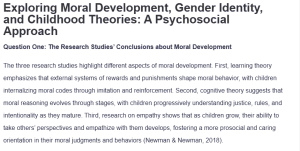Exploring Moral Development, Gender Identity, and Childhood Theories: A Psychosocial Approach
Question One: The Research Studies’ Conclusions about Moral Development
The three research studies highlight different aspects of moral development. First, learning theory emphasizes that external systems of rewards and punishments shape moral behavior, with children internalizing moral codes through imitation and reinforcement. Second, cognitive theory suggests that moral reasoning evolves through stages, with children progressively understanding justice, rules, and intentionality as they mature. Third, research on empathy shows that as children grow, their ability to take others’ perspectives and empathize with them develops, fostering a more prosocial and caring orientation in their moral judgments and behaviors (Newman & Newman, 2018).
Question Two: The Lee Gender Identity Case Study
The narrative reveals Lee’s gender identification development through her tomboyish behaviors, likely influenced by her father’s desire for a son. Despite her preferences for traditionally masculine activities, she remains aware of her identity as a girl.
Second, Lee identified with both her parents differently. Her father encouraged her to engage in rough-and-tumble play, where she acted as a surrogate son. In contrast, her mother represented traditional feminine roles, expecting Lee to conform to more conventional girlhood behaviors.
The physical environment, such as her outdoor play with cousin Bob, reinforced Lee’s preference for rough play, shaping her gender identity as one that aligned more with non-traditional female roles during early childhood.
Question Three: Contrasting Early School Age and Middle Childhood Theories
Self-Theory vs. Self-Evaluation
Early childhood self-theory refers to the developing sense of self that results from exploration and social interaction. In middle childhood, self-evaluation becomes more complex as the child begins to compare themselves with others and judge themselves on the basis of external standards and the feedback of others.
Peer Play vs. Team Play
At an early school age, peer play is more imaginative and unstructured and often revolves around fantasy. In middle childhood, the concept of team play includes structured roles, rules, and cooperation since teamwork, competition, and organized group activities are becoming more central.
References
Newman, B. & Newman, P. (2018). Development through Life: A psychosocial approach (13th ed.). Cengage Learning.
ORDER A PLAGIARISM-FREE PAPER HERE
We’ll write everything from scratch
Question 
In a post, answer the following questions in 3-5 sentences each:
- Question 1: What has each research study (chart indicates 3 research studies) concluded about moral development? See chart and text information on p. 249 in the text.
- Question 2: Read the Lee Gender Identity Case Study on p. 231-232. Answer questions 1-3 on p. 232.
- Question 3: Contrast these theories during early school age and middle childhood.
- Self-Theory vs. Self-Evaluation
- Peer Play vs. Team Play

Exploring Moral Development, Gender Identity, and Childhood Theories: A Psychosocial Approach
Class Books are: NEWMAN / DEVELOPMENT THROUGH LIFE